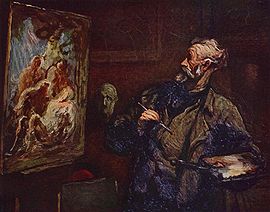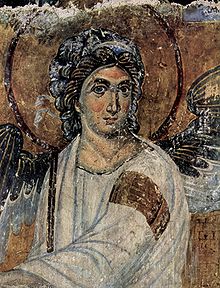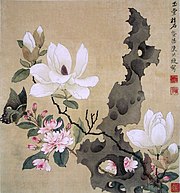Painting is the practice of applying paint, pigment, color or other medium[1] to a surface (support base). The application of the medium is commonly applied to the base with a brush but other objects can be used. In art the term describes both the act and the result which is called a painting. Paintings may have for their support such surfaces as walls, paper, canvas, wood, glass, lacquer, clay, copper or concrete, and may incorporate multiple other materials including sand, clay, paper, gold leaf as well as objects.
Painting is a mode of expression and the forms are numerous. Drawing, composition or abstraction and other aesthetics may serve to manifest the expressive and conceptual intention of the practitioner. Paintings can be naturalistic and representational (as in a still life or landscape painting), photographic, abstract, be loaded with narrative content, symbolism, emotion or be political in nature.
A portion of the history of painting in both Eastern and Western art is dominated by spiritual motifs and ideas; examples of this kind of painting range from artwork depicting mythological figures on pottery to Biblical scenes rendered on the interior walls and ceiling of The Sistine Chapel, to scenes from the life of Buddha or other scenes of eastern religious origin.
Elements
[edit] Intensity
What enables painting is the perception and representation of intensity. Every point in space has different intensity, which can be represented in painting by black and white and all the gray shades between. In practice, painters can articulate shapes by juxtaposing surfaces of different intensity; by using just color (of the same intensity) one can only represent symbolic shapes. Thus, the basic means of painting are distinct from ideological means, such as geometrical figures, various points of view and organization (perspective), and symbols. For example, a painter perceives that a particular white wall has different intensity at each point, due to shades and reflections from nearby objects, but ideally, a white wall is still a white wall in pitch darkness. In technical drawing, thickness of line is also ideal, demarcating ideal outlines of an object within a perceptual frame different from the one used by painters.[edit] Color and tone
Color and tone are the essence of painting as pitch and rhythm are of music. Color is highly subjective, but has observable psychological effects, although these can differ from one culture to the next. Black is associated with mourning in the West, but in the East, white is. Some painters, theoreticians, writers and scientists, including Goethe, Kandinsky, and Newton, have written their own color theory. Moreover the use of language is only a generalization for a color equivalent. The word "red", for example, can cover a wide range of variations on the pure red of the visible spectrum of light. There is not a formalized register of different colors in the way that there is agreement on different notes in music, such as C or C♯ in music. For a painter, color is not simply divided into basic and derived (complementary or mixed) colors (like red, blue, green, brown, etc.).Painters deal practically with pigments, so "blue" for a painter can be any of the blues: phtalocyan, Paris blue, indigo, cobalt, ultramarine, and so on. Psychological, symbolical meanings of color are not strictly speaking means of painting. Colors only add to the potential, derived context of meanings, and because of this the perception of a painting is highly subjective. The analogy with music is quite clear—sound in music (like "C") is analogous to light in painting, "shades" to dynamics, and coloration is to painting as specific timbre of musical instruments to music—though these do not necessarily form a melody, but can add different contexts to it.

Georges Seurat (1859–91), Circus Sideshow (1887–88)
[edit] Rhythm
Rhythm is important in painting as well as in music. If one defines rhythm as "a pause incorporated into a sequence", then there can be rhythm in paintings. These pauses allow creative force to intervene and add new creations—form, melody, coloration. The distribution of form, or any kind of information is of crucial importance in the given work of art and it directly affects the esthetical value of that work. This is because the esthetical value is functionality dependent, i.e. the freedom (of movement) of perception is perceived as beauty. Free flow of energy, in art as well as in other forms of "techne", directly contributes to the esthetical value.[edit] Non-traditional elements
Modern artists have extended the practice of painting considerably to include, for example, collage, which began with Cubism and is not painting in the strict sense. Some modern painters incorporate different materials such as sand, cement, straw or wood for their texture. Examples of this are the works of Jean Dubuffet and Anselm Kiefer. There is a growing community of artists who use computers to paint color onto a digital canvas using programs such as Adobe Photoshop, Corel Painter, and many others. These images can be printed onto traditional canvas if required.[edit] History
Main article: History of painting
The oldest known paintings are at the Grotte Chauvet in France, claimed by some historians to be about 32,000 years old. They are engraved and painted using red ochre and black pigment and show horses, rhinoceros, lions, buffalo, mammoth or humans often hunting. However the earliest evidence of painting has been discovered in two rock-shelters in Arnhem Land, in northern Australia. In the lowest layer of material at these sites there are used pieces of ochre estimated to be 60,000 years old. Archaeologists have also found a fragment of rock painting preserved in a limestone rock-shelter in the Kimberley region of North-Western Australia, that is dated 40 000 years old. [1] There are examples of cave paintings all over the world—in India, France, Spain, Portugal, China, Australia, etc.In Western cultures oil painting and watercolor painting have rich and complex traditions in style and subject matter. In the East, ink and color ink historically predominated the choice of media with equally rich and complex traditions.
The invention of photography had a major impact on painting. In 1829, the first photograph was produced. From the mid to late 19th century, photographic processes improved and, as it became more widespread, painting lost much of its historic purpose to provide an accurate record of the observable world. There began a series of art movements into the 20th century where the Renaissance view of the world was steadily eroded, through Impressionism, Post-Impressionism, Fauvism, Expressionism, Cubism and Dadaism. Eastern and African painting, however, continued a long history of stylization and did not undergo an equivalent transformation at the same time.
Modern and Contemporary Art has moved away from the historic value of craft and documentation in favour of concept; this led some to say in the 1960s that painting, as a serious art form, is dead. This has not deterred the majority of living painters from continuing to practice painting either as whole or part of their work. The vitality and versatility of painting in the 21st century belies the premature declarations of its demise. In an epoch characterized by the idea of pluralism, there is no consensus as to a representative style of the age. Important works of art continue to be made in a wide variety of styles and aesthetic temperaments, the marketplace being left to judge merit.
Among the continuing and current directions in painting at the beginning of the 21st century are Monochrome painting, Hard-edge painting, Geometric abstraction, Appropriation, Hyperrealism, Photorealism, Expressionism, Minimalism, Lyrical Abstraction, Pop Art, Op Art, Abstract Expressionism, Color Field painting, Neo-expressionism, Collage, Intermedia painting, Assemblage painting, Computer art painting, Postmodern painting, Neo-Dada painting, Shaped canvas painting, environmental mural painting, traditional figure painting, Landscape painting, Portrait painting, and paint-on-glass animation.
[edit] Aesthetics and theory
Main article: Theory of painting

Apelles or the Art of painting (detail), relief of the Giotto's Bell Tower in Florence, Italy, Nino Pisano, 1334–1336
Hegel recognized the failure of attaining a universal concept of beauty and in his aesthetic essay wrote that Painting is one of the three "romantic" arts, along with Poetry and Music for its symbolic, highly intellectual purpose.[2][3] Painters who have written theoretical works on painting include Kandinsky and Paul Klee.[4][5] Kandinsky in his essay maintains that painting has a spiritual value, and he attaches primary colors to essential feelings or concepts, something that Goethe and other writers had already tried to do.
Iconography is the study of the content of paintings, rather than their style. Erwin Panofsky and other art historians first seek to understand the things depicted, then their meaning for the viewer at the time, and then analyze their wider cultural, religious, and social meaning.
In 1890, the Parisian painter Maurice Denis famously asserted: "Remember that a painting—before being a warhorse, a naked woman or some story or other—is essentially a flat surface covered with colors assembled in a certain order."[6] Thus, many 20th-century developments in painting, such as Cubism, were reflections on the means of painting rather than on the external world, nature, which had previously been its core subject. Recent contributions to thinking about painting has been offered by the painter and writer Julian Bell. In his book What is Painting?, Bell discusses the development, through history, of the notion that paintings can express feelings and ideas.[7] In Mirror of The World Bell writes:
‘A work of art seeks to hold your attention and keep it fixed: a history of art urges it onwards, bulldozing a highway through the homes of the imagination.’[8]
[edit] Painting media

Honoré Daumier (1808–79), The Painter.
[edit] Oil
Oil painting is the process of painting with pigments that are bound with a medium of drying oil—especially in early modern Europe, linseed oil. Often an oil such as linseed was boiled with a resin such as pine resin or even frankincense; these were called 'varnishes' and were prized for their body and gloss. Oil paint eventually became the principal medium used for creating artworks as its advantages became widely known. The transition began with Early Netherlandish painting in northern Europe, and by the height of the Renaissance oil painting techniques had almost completely replaced tempera paints in the majority of Europe.[edit] Pastel
Pastel is a painting medium in the form of a stick, consisting of pure powdered pigment and a binder.[9] The pigments used in pastels are the same as those used to produce all colored art media, including oil paints; the binder is of a neutral hue and low saturation. The color effect of pastels is closer to the natural dry pigments than that of any other process.[10] Because the surface of a pastel painting is fragile and easily smudged, its preservation requires protective measures such as framing under glass; it may also be sprayed with a fixative. Nonetheless, when made with permanent pigments and properly cared for, a pastel painting may endure unchanged for centuries. Pastels are not susceptible, as are paintings made with a fluid medium, to the cracking and discoloration that result from changes in the color, opacity, or dimensions of the medium as it dries.[edit] Acrylic
Acrylic paint is fast drying paint containing pigment suspension in acrylic polymer emulsion. Acrylic paints can be diluted with water, but become water-resistant when dry. Depending on how much the paint is diluted (with water) or modified with acrylic gels, media, or pastes, the finished acrylic painting can resemble a watercolor or an oil painting, or have its own unique characteristics not attainable with other media. The main practical difference between most acrylics and oil paints is the inherent drying time. Oils allow for more time to blend colors and apply even glazes over underpaintings. This slow drying aspect of oil can be seen as an advantage for certain techniques, but in other regards it impedes the artist trying to work quickly.[edit] Watercolor
Watercolor is a painting method in which the paints are made of pigments suspended in a water soluble vehicle. The traditional and most common support for watercolor paintings is paper; other supports include papyrus, bark papers, plastics, vellum or leather, fabric, wood, and canvas. In East Asia, watercolor painting with inks is referred to as brush painting or scroll painting. In Chinese, Korean, and Japanese painting it has been the dominant medium, often in monochrome black or browns. India, Ethiopia and other countries also have long traditions. Fingerpainting with watercolor paints originated in China.[edit] Ink
Ink paintings are done with a liquid that contains pigments and/or dyes and is used to color a surface to produce an image, text, or design. Ink is used for drawing with a pen, brush, or quill. Ink can be a complex medium, composed of solvents, pigments, dyes, resins, lubricants, solubilizers, surfactants, particulate matter, fluorescers, and other materials. The components of inks serve many purposes; the ink’s carrier, colorants, and other additives control flow and thickness of the ink and its appearance when dry.[edit] Hot wax
Encaustic painting, also known as hot wax painting, involves using heated beeswax to which colored pigments are added. The liquid/paste is then applied to a surface—usually prepared wood, though canvas and other materials are often used. The simplest encaustic mixture can be made from adding pigments to beeswax, but there are several other recipes that can be used—some containing other types of waxes, damar resin, linseed oil, or other ingredients. Pure, powdered pigments can be purchased and used, though some mixtures use oil paints or other forms of pigment. Metal tools and special brushes can be used to shape the paint before it cools, or heated metal tools can be used to manipulate the wax once it has cooled onto the surface. Other materials can be encased or collaged into the surface, or layered, using the encaustic medium to adhere it to the surface.[edit] Fresco
Fresco is any of several related mural painting types, done on plaster on walls or ceilings. The word fresco comes from the Italian word affresco [afˈfresːko] which derives from the Latin word for "fresh". Frescoes were often made during the Renaissance and other early time periods. Buon fresco technique consists of painting in pigment mixed with water on a thin layer of wet, fresh, lime mortar or plaster, for which the Italian word for plaster, intonaco, is used. A secco painting, in contrast, is done on dry plaster (secco is "dry" in Italian). The pigments thus require a binding medium, such as egg (tempera), glue or oil to attach the pigment to the wall.
A Fresco "White Angel" from Mileševa, Serbia



